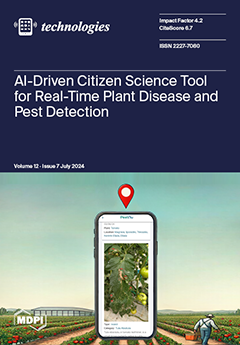In recent years, the integration of smartphone technology with novel sensing technologies, Artificial Intelligence (AI), and Deep Learning (DL) algorithms has revolutionized crop pest and disease surveillance. Efficient and accurate diagnosis is crucial to mitigate substantial economic losses in agriculture caused by diseases
[...] Read more.
In recent years, the integration of smartphone technology with novel sensing technologies, Artificial Intelligence (AI), and Deep Learning (DL) algorithms has revolutionized crop pest and disease surveillance. Efficient and accurate diagnosis is crucial to mitigate substantial economic losses in agriculture caused by diseases and pests. An innovative Apple
® and Android™ mobile application for citizen science has been developed, to enable real-time detection and identification of plant leaf diseases and pests, minimizing their impact on horticulture, viticulture, and olive cultivation. Leveraging DL algorithms, this application facilitates efficient data collection on crop pests and diseases, supporting crop yield protection and cost reduction in alignment with the Green Deal goal for 2030 by reducing pesticide use. The proposed citizen science tool involves all Farm to Fork stakeholders and farm citizens in minimizing damage to plant health by insect and fungal diseases. It utilizes comprehensive datasets, including images of various diseases and insects, within a robust Decision Support System (DSS) where DL models operate. The DSS connects directly with users, allowing them to upload crop pest data via the mobile application, providing data-driven support and information. The application stands out for its scalability and interoperability, enabling the continuous integration of new data to enhance its capabilities. It supports AI-based imaging analysis of quarantine pests, invasive alien species, and emerging and native pests, thereby aiding post-border surveillance programs. The mobile application, developed using a Python-based REST API, PostgreSQL, and Keycloak, has been field-tested, demonstrating its effectiveness in real-world agriculture scenarios, such as detecting
Tuta absoluta (Meyrick) infestation in tomato cultivations. The outcomes of this study in
T. absoluta detection serve as a showcase scenario for the proposed citizen science tool’s applicability and usability, demonstrating a 70.2% accuracy (
mAP
50) utilizing advanced DL models. Notably, during field testing, the model achieved detection confidence levels of up to 87%, enhancing pest management practices.
Full article





